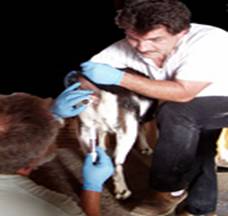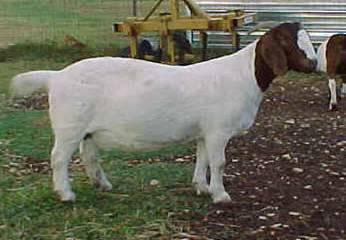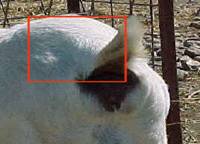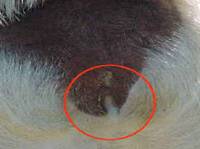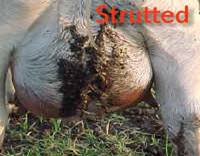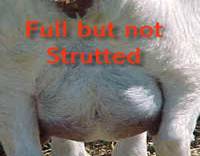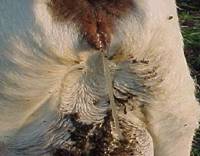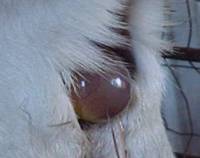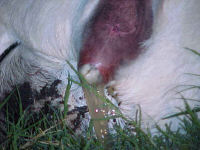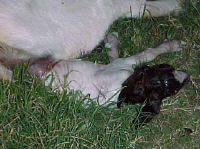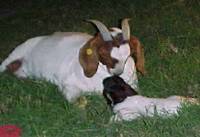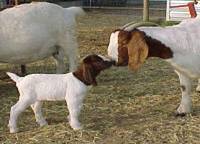
|
|||||||||||||||||||||||||||||||||||||||||||||||||||||||
| Livestock :: Goat :: Reproduction | |||||||||||||||||||||||||||||||||||||||||||||||||||||||
Reproduction Doe
Signs of heat
Buck A young buck may be selected based on the production performance of its dam and/or its sisters. Their yield must be 1.5 kg per day. Bucks should be masculine and virile with straight legs and long feet. Preference may be given to the one in the twins or triplets. Must possess good libido and good semen quality. While selecting male goats for meat purpose weight at 6 months should not be less than 12 kg. A buck should be put into service only when it is 10 to 12 months of age. Gestation periodSymptoms at various stages of gestation in goats
ARTIFICIAL INSEMINATION IN GOATS
Preventive measures We do preventive measures that will allow our animals have optimum growth and health performance with the minimum amount of our labor and expense. Each breeder must determine what is the most important preventive measures for their situation. The type of preventive measures taken by breeders can vary widely according to the following:
Preparing doe
The focus on management of pregnant does is:
The basic needs can be summarized into exercise, proper nutrition and preventative health management steps.
Preparing doe Exercise Pregnant does need to continue as much normal activity as possible. They need the strength to carry the extra weight during the last two months and go through the labor successfully. A doe should not come into pregnancy or the first two months too fat. The normal activity of walking around grazing should continue. Nutrition Nutrition is very important in the last two months of pregnancy. 70 % of the weight of the kid(s) is developed from around day 100 to the birthing date. Undernourishment during this period will result in the birth of smaller kids, increased mortality and slower growth rates. A doe in late pregnancy has additional requirements from their supply of food, especially for energy foods. Also the uterus and its contents take up a large amount of space in the doe's abdomen so that she cannot eat enough poor-quality foodstuff to provide all of their requirements. The doe's body is designed to ensure that the kids get enough energy food at the expense of her own tissues. Her body will rob her own reserves to provide nutrition to the kids. A doe's appetite often drops off at this time and the volume of the uterus contents and the internal fat stored will limit the volume of feed she can consume. Therefore the quality of feed must be increased. High quality hay should be fed during this period. Goats that eat a lot of hay during pregnancy maintain that ability to ingest increased levels of roughage during lactation. Concentrate food with higher levels of protein can be fed to the does. You do not want to just feed higher levels of concentrate feed. High volumes of concentrate feed has been associated with slow birthing and poor cervical dilations. We feed our pregnant does a concentrate feed with 16-17% protein level. Ensure the does have access to trace-mineralized salt and clean water. Preventive Management
Signs of labor We try to be with each of our does that are about to kid to lend a hand if there are any problems. We are with our does kidding 85-90% of the time. The only reason we are not with 100% of them is because they kidded during the middle of the night and we did not read the signs of eminent labor. If we see the signs, we will be with them during the middle of the night. Below is some of the type of signs to help you better understand when your doe is about to kid. Calendar - We do individual breeding of our does. They are placed with a specific buck when the doe comes into heat. We will leave the doe with the buck for two days and then remove them. We document the date the doe was serviced. From that date, we will start to closely watch the doe around 149 days from the breeding date. Tail Dropping - As the doe gets close to kidding time, her body will start to adjust to allow the pelvic bones to spread out. Look at the back bone of the goat as it connects to the tail area. Either side of the tail bone will indent showing the body is getting ready. The picture to the right was taken 8 days before she kidded. This is not the best sign. It is not very specific and sometimes we just don't see the tail dropping.
Losing Plug - Our vet calls this "losing their plug". You will see a small amount of creamy jell leaking from the vulva. The picture to the right was taken at the same time as the picture for the tail dropping, 8 days before she actually kidded. We have seen small drippings like this up to 2 weeks prior to the doe kidding, therefore this is not a very good timing signal unless it changes into "streaming". Streaming will be discussed later.
Bag Strutting - This is one of the better signs for estimating eminent labor. The top picture was taken 8 days prior to kidding and the bag looks full but the skin is not a shiny texture like the bottom picture. When the bag is strutted, the skin is as tight as it can get and the skin will be very shiny. The dirt on the bag in the bottom picture is not part of the strutted sign. That is coming from another sign, "streaming", which will be discussed later. The bottom picture was taken 2 hours before she went into labor. The bag changed from looking like the top picture to the bottom picture in about 3 hours. We have had a few does that did not have a strutted bag prior to kidding. The bag filled up after kidding, but that is not the norm. When we see the bag get strutted like the bottom picture, we expect labor to be very soon and will start to watch for three other signs...streaming, doe going off by herself, and soft talking by the doe.
Streaming - This is an extension of the "losing the plug". The difference is in the amount of creamy mucus coming from the doe. This picture was taken at the same time as the "bag strutting" picture which was 2 hours before labor started. You can see the large amount of mucus streaming from the doe is what caused all of the muddy dirt on the bag. One hour earlier, there had been not streaming like this. It had looked similar to the "losing the plug" sign. When we see streaming like this, we expect the doe to start labor within 4-5 hours at least. We have seen does stream like this for several days and not go into labor and we get concerned when this occurs. Especially if the mucus changes to a strawberry color. That is normally a sign that something is wrong with the kids inside. I want to be alone - When we see a doe going off by herself, we get our kidding tools ready. We expect labor within 4-5 hours at least .Especially if we have seen strutting and streaming. Soft Talking - Another sure sign of eminent labor is when the doe starts baaing very soft. This is a different sound than she normally makes and much softer. She will also be looking back at her stomach quite often and can't find a comfortable place to stand or lay. We expect labor within 4-5 hours at least. Pawing the ground - The doe will start pawing the ground like she is trying to clear a place for kidding. Labor and kidding Initial Labor One should have to identify the initial labor when the doe starts labor pushes. Do document the starting time for later evaluation if things are progressing ok. Watch the vulva during the labor pushes to see if it is trying to open up and extend outward. It is extended and opening up. There may be a dark colored bubble, 3-5 inches in diameter, initially come out and erupt with liquid being released. In some births have no bubble comes out. Potential Problems If the doe continues to have labor pushes for 1-2 hours and the vulva does not show signs of extending and trying to open, we consider there is a problem with the kid being able to come out properly. They may not be positioned properly or the cervix may not have expanded sufficiently to allow the kid to enter the birth cannel. It is likely that someone, (vet or you if you know what you are doing) may have to go inside to help. A vet may have to do a C-section to deliver the kids. 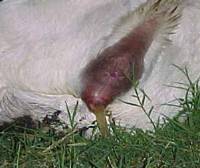
If the streaming mucus is or turns strawberry red color, there may be problems with the kids.There are several does have this and the results ended up being the kids were already dead. Water Bubble One of the first activities of kidding can be a transparent bubble protruding that contains liquids. This does not always occur but is a normal process in the birthing. The doe will go into labor doing pushes and groaning. This transparent bubble will start to appear. She may get up and down during this period. Eventually it will burst and the doe will likely drink some of this liquid. A similar bubble may come out with the kid inside. If this is the bag with the kid inside, you will be able to see inside the bubble and one or more hooves or a nose will be seen. Potential Problems
First Sign of Kid The first real sign we look for is some sign of a kid starting out the vulva. The picture to the bottom shows a single hoof starting to appear. If you look closely at the hoof, you will be able to tell if the kid will be coming out front first or rear first. If you see the top of the hoof, it is head first. If you see the bottom of the hoof, it is rear first. Both are ok. We want to continue to observe the progress to ensure the kid continues to move outward. Don't try to rush in too soon to help. Sometimes it takes a little time for the progress to occur. Potential Problems No progress. We will step in to help by trying to help by carefully pulling on the leg during labor pushes. If you doe is not tame or gentle, this may be difficult to do. If she continues with no progress, someone (vet or you if knowledgeable) will need to go inside to determine what is blocking the progress. It is likely that the kid is not positioned correctly as shown to the right.
Two legs and a Mouth The picture in the down shows progress is being made and there are now two legs and notice that the tip of the mouth are at the exit. We noticed that both legs are front legs and the head is in position with the front legs to come out properly. As the head or nose starts to protrude, we watch closely to see if the kid has started to breathe on its own. If it has, we want to ensure that the nose area is cleared of anything that may not allow the kid to breathe. Sometimes we have a doe kidding and part of the head will start out and then as the doe moves around the head will go back in. We will watch closely for continued progress. Many times you will be able to see the kid's leg move around showing it is ok. Potential Problems

Nearly Complete The hardest part seems to be getting the head to come out. After the head is out, the rest of the body should come out quickly. We step in to check the kid has nothing in the mouth area and clear anything away from the head. We will watch for breathing signs and look to ensure the nose area is clear. The kid may still be in the sack and we will step in to get the kid out of the sack and breathing. Potential Problems Head and feet come out but no additional progress. We have had a few kids that got their head and feet out but could not make any additional progress. We had to call a vet to deliver the kid. It turned out that the kid's shoulders were hunched forward and not positioned to go through the cervix area. He had to push the kid partially back in to position the shoulders correctly. Cleanup We make sure either the doe starts cleaning up the kid or we will lay the kid in front of the doe to allow her to start cleaning up. The doe will nibble at all of the mucus on the kid normally starting at the head. She needs to be able to clean up her kids in order to identify with the kid. Cleanup may be interrupted by going into labor again with more kids. We watch closely to ensure she does not lay on a kid already born while she tries to deliver other kids.
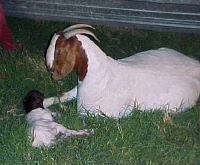
Welcome to the World If all goes ok, the kid should start moving around trying to stand within an hour or sooner. Rubber legs. We have had some kids that could not stand up on their back legs because they were so rubbery. The will normally correct itself within a week. You need to ensure the kid is getting the needed nutrition until they can get around on their own.
Next Day and Success
First two hours
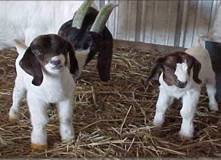
Shedding afterbirth Exception: Goat nutrition Protein Protein is the only nutrient that contains nitrogen. Protein quality - a term referring to the amino acid content - has no significance in ruminant nutrition, except at exceptionally high levels of milk production. Rumen microorganisms manufacture their own body protein, consisting of all the necessary amino acids, which are later digested by the host animal. EnergyAll discussions of nutrition seem to begin with energy, probably because this is the best defined requirement of farm animals and is expensive. Most of the goat's energy comes from the breakdown of the fiber of forages, while the remainder comes from the burning up of concentrate starches and fats. Over a longer period of time effects such as retarded growth, delayed puberty, and decreased fertility will become apparent. MineralsMany minerals are required by the goat. Most can be obtained from good forage and a regular concentrate mixture. The major minerals of concern are calcium, phosphorus, and salt, which are usually added to the ration either in the grain mix or by free-choice feeding. Goats do not consume minerals free choice according to their needs. It is, therefore, recommended that minerals be force-fed through the grain mixture or mixed with a succulent feed like silage or green chop, if possible. The ratio of calcium to phosphorus is important and should be kept around 2:1. If these minerals must be fed free-choice, such as to dry goats and yearlings, a good mixture is one containing equal parts of salt and dicalcium phosphate, or a similar commercial mix. VitaminsVitamins are needed by the body in small amounts. Since all the B vitamins and vitamin K are produced in the rumen and vitamin C is manufactured in the body tissues, the only vitamins of concern in ruminant nutrition are vitamins A, D, and E. During the late spring, summer, and early fall the animals can get all they need from green pastures and plenty of sunshine. In addition, they can store a good supply of these vitamins to carry them into the winter months. FatsFats are of little importance in the ruminant ration. Practically all feeds contain small amounts of fat, and added levels are not practical. A level of 1.5 - 2.5 percent in the grain mixture is normal. WaterThis is the least expensive feed ingredient, yet a deficiency will affect milk production more quickly than the lack of any other nutrient. Water is not only the largest single constituent of nearly all living plant and animal tissue, but it also performs exceedingly important functions during digestion, assimilation of nutrients, excretion of waste products, control of body temperature, and the production of milk. Ready access to water is important. Goats with water constantly available have been shown to produce more milk than those watered twice daily and over 10 percent more than those watered only once per day. | |||||||||||||||||||||||||||||||||||||||||||||||||||||||
| © 2009-15 TNAU. All Rights Reserved. |
|||||||||||||||||||||||||||||||||||||||||||||||||||||||
